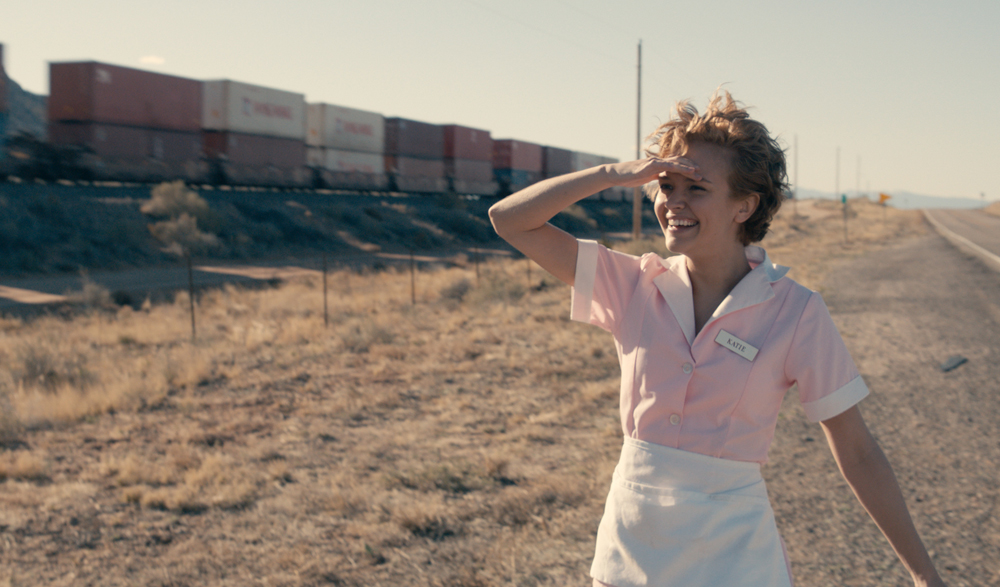You can see immediately why Wayne Roberts couldn’t stop thinking about Katie, an effervescent creation of his in college that he didn’t exactly know what to do with at the time. Wide-eyed and unflappable, she aspires to be a beautician in San Francisco, saving up every tip she receives as a waitress at her local diner in a town time forgot in Arizona. Yet she doesn’t resent the place she grew up in or even her mother (Mirelle Enos) who continually fails to put her needs above her own – in fact, her instinct is to give so much to others while she can since she knows how hard life is there. Still, she knows she needs to leave.
While Katie’s stuck in the desert, the majesty of the mountains and dunes around her teasing of greater horizons, “Katie Says Goodbye,” Roberts’ transcendent feature debut, lifts off because her unique way of looking at the world is articulated so beautifully, even as tragedy befalls her. Armed with a brilliant and singular lead performance from Olivia Cooke, the film plays out like a fairy tale with its dreamy pastels and the simplicity of its intent but resonates far deeper as hints of all the pain that’s shaped Katie comes out in her interactions with all the people in her town who have settled for less. Nothing comes as expected in the film, from a sterling yet eclectic supporting cast that includes Christopher Abbott, Chris Lowell, Jim Belushi, Mary Steenburgen and Keir Gilchrist in roles largely against type to its seamless blend of the darker impulses of much of the town to take advantage of Katie’s generosity of spirit with the relentless optimism that she puts up to protect herself.
It’s a special film, and in the midst of a busy Toronto Film Festival where the film just premiered, Roberts spoke about how he came to filmmaking, crafting the film’s distinctive visual style and how having such a strong lead in Cooke made things simple both in form and function.
It was interesting to read this actually began life as a potential novel idea ten years ago, but you decided to develop this as a film instead. How did that change come about?
Originally, I wanted to write as much as possible and to only direct on occasion for the stories that I felt that I would be the absolute best person to tell that story. That needn’t be something that I do every time I write. I also wanted to have the freedom to write novels and to be taken seriously doing such, so the plan was to originally write it as a novel, publish that, and then to go ahead and do the script and either have another director do it or do it myself. Sean Durkin, one of my closest friends from NYU for the last ten years, encouraged me just to write the script first, and then also direct the film, too. At the time, I had recently turned 30, and [making movies] is what I have wanted to do since I was nine, so it was time to do it. You spend your twenties living life and absorbing as much as you possibly can, and then once you get to your thirties, at least from my trajectory in life, you focus on the work and doing what you can with your life.
How did making movies become the artistic medium to pursue?
I was fascinated with films before [I was nine], too, which is something that I never actually thought about that I could actually do. I think it’s the ultimate art form. You have your hand within every single medium. You have the compositions with the shots [where] essentially you’re painting a picture with that. You’re doing theater with performance. You’re doing music with the score and with the sound design. Color correction, once again, is painting. You’re combining all these amazing art forms into one and it’s amazing.
For “Katie Says Goodbye,” did you have a full story in mind or really just the idea of this character?
Just the title and, of course, seeing who Katie was in the beginning of the film and at the very, very end. Once that connective thread existed between myself and Katie, it was really just allowing her to tell her story and to not interfere. It came quite fast once I sat down to actually write that story. From the moment that I thought of Katie, I always felt her presence.
It was intriguing that most of her dialogue in the beginning starts with a question…
That wasn’t intentional, but again, that’s where I was able to step back and let her tell her story. Katie is insanely curious about the world and about other people and she cares about them. Most of the characters within the film are very taciturn. They don’t speak a whole lot. For her to engage with the world and with other people, it often requires her to initiate. There’s only once or twice, I think within the entire film in which, at least on [Christopher Abbott’s character] Bruno’s end, that he asks a question to Katie and/or initiates a conversation of some sort. Her maneuvering around throughout the world requires her active participation. In terms of her relationships, nothing’s passive.
Was there any significance to the Arizona setting?
Again, it was one of those things where it just came along with Katie was where the story took place. We shot in New Mexico, which has some sort of spiritual sense to it, but Arizona was the spot to set the location because I feel like it has some bite.
I [also] love the pastels [of that region]. I was very particular about that. My parents live in Utah and just seeing the sunsets there in the Southwest, if you hit it right at the beginning or at the tail end of winter you have these beautiful, feminine pastels and it was important to shoot at either end of [the season]. We were able to do so and really capture those colors. Of course, we situated everything with the production design and the costume design, too, to really make the film as feminine as possible.
You’re able to tell so much of the story on Katie’s face, and Olivia is so expressive – did you know you’d find an actress who could do that or once she was onboard, did it change what you could do?
That is what I’d hoped for. I didn’t know if I was going to be able to achieve that. If you’re going to have a film and you have scenes play out in it’s entirety or if you try to cut as little as possible, it is entirely dependent upon your cast and whether or not they can deliver a performance from beginning to end. I hoped for it. There are so few [who can do that]. Olivia was 20 when we shot that film. She was – and is – so young, but she has such maturity and wisdom to her that she could go to that place and become that character. She could turn it on and she can turn it off and it enabled me to realize the dream that I had of keeping the story as simple as possible.
There could be a great number of actresses that would not be able to make this film [and allow me to] execute this film, craft-wise, in the way that I wanted to, otherwise you might have a film in which there are 1800 cuts. On my end, performance will trumps all. I don’t give a damn if we get the shot and I don’t care if it’s out of focus. If I have an actress that cannot deliver that scene in its totality, then I’m going to have to cut a great number of times. God bless Olivia in the fact that I did not have to do so.
She’s incredible. Was there something surprising that happened during the shoot that wound up making it into the final film that you’re really happy about?
Yeah, oftentimes our cast would surprise me. Our [cinematographer Paula Huidobro] would surprise me, as well, too. We would do our blocking, and a lot of it was quite intricate. There were moments in which I would not call “cut” and then what the actor was doing, and then what Paula was doing in response to the actor, a lot of it made it into the final film. I’m obsessed with it. When Bruno takes the convertible and drives off, it was such a beautiful shot. Even better than what I thought we could get.
Was there particularly crazy day of shooting on this?
We had a lot of crazy days because we had quite an aggressive schedule, but of course, because it is so performance-driven I would like to do a great number of takes. The [climactic] scene, we gave ourselves an entire day for that. There were a lot of difficult days, but that was certainly one that had a different tone and was much more somber whereas, otherwise, when we were shooting the film we were having a great time and we’re constantly laughing and joking around.
Was directing a feature what you thought it was going to be?
It was different in the fact that it just felt like I was doing what I meant to be doing. I never thought that I would experience joy like that. I love the process of writing. It’s an incredibly private practice that you do. When you’re actually on set with your actors, and then also with your [cinematographer] and you’re all pushing towards something and realizing something together, so much is left unspoken. That is such an incredible feeling that I’m addicted to it. Again, I haven’t felt joy like that before in my life.
“Katie Says Goodbye” is now available on iTunes.




